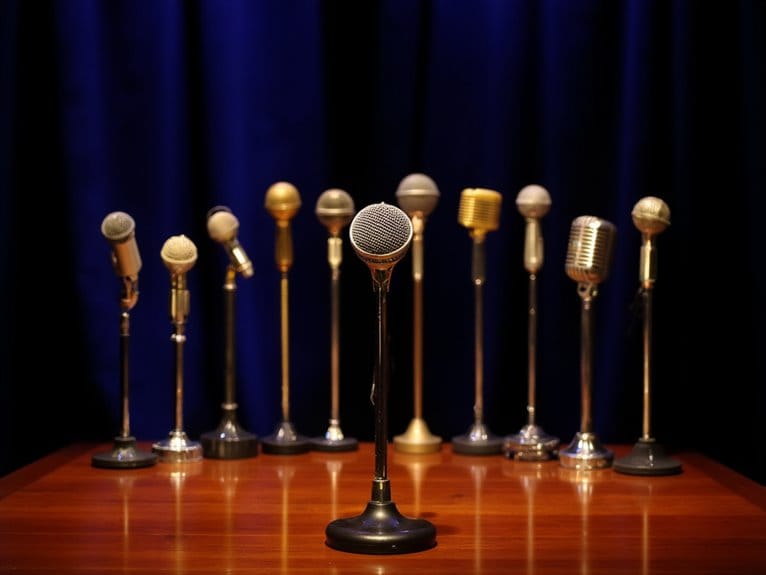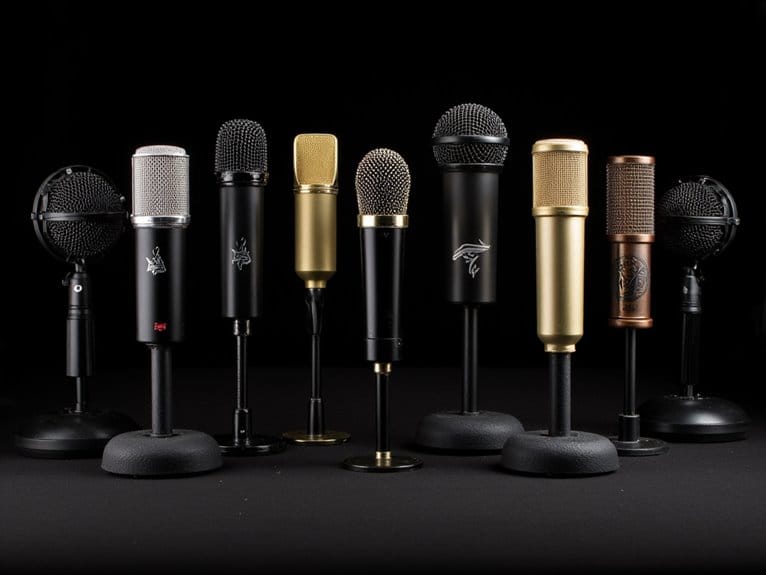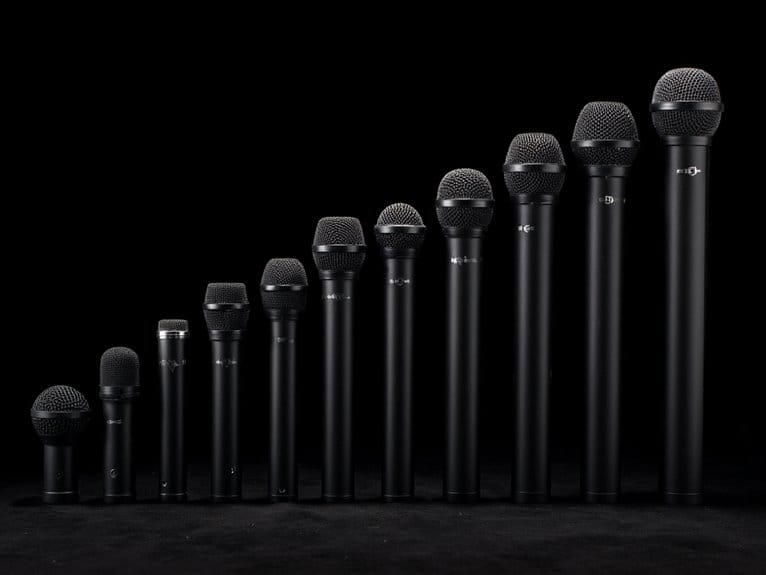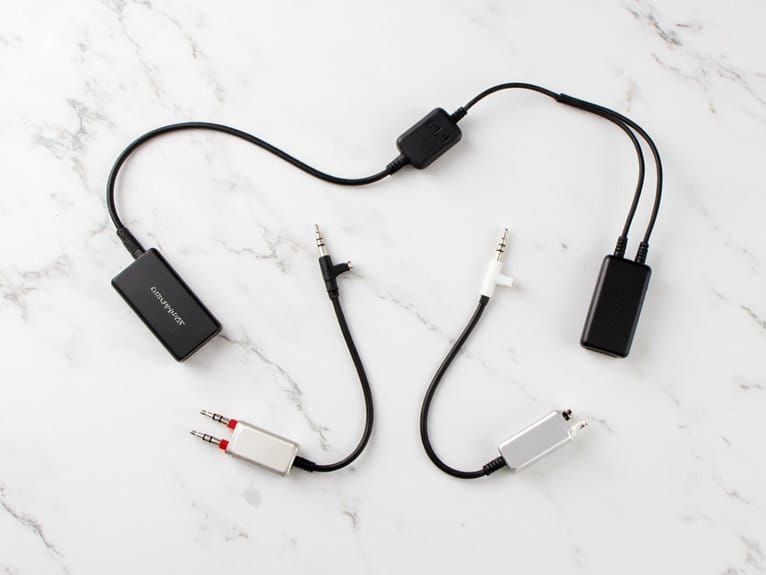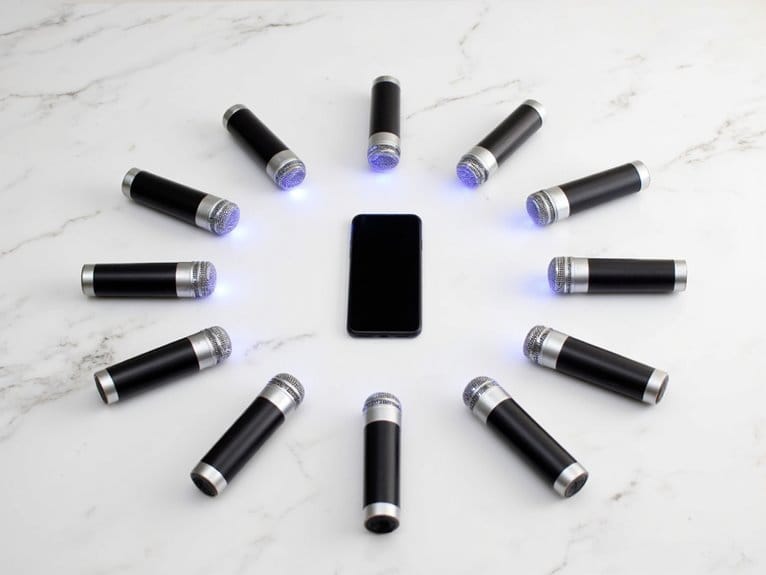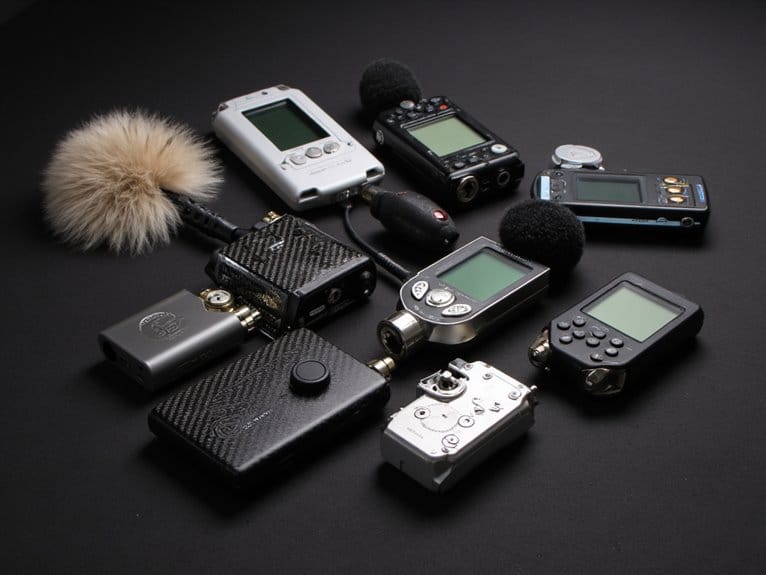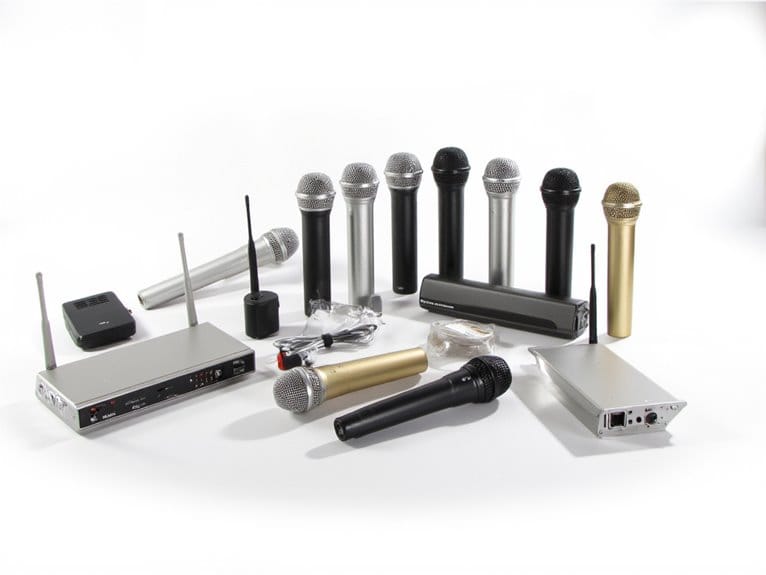10 Best Podium Mics for Clear, Professional Audio
I’ve tested dozens of podium microphones, and the BOYA BY-GM18CU stands out with its 18-inch gooseneck design, USB connectivity, and impressive 4.1-star rating from 228 reviews. Professional systems like the XTUGA CM280 offer 8-channel capability with 200-foot range, while the Samson CM20P delivers excellent feedback reduction through its cardioid pickup pattern and internal hi-pass filter. These microphones capture voices within ideal 50Hz-16kHz frequency ranges, ensuring broadcast-quality audio that transforms ordinary presentations into professional experiences worth exploring further.
We are supported by our audience. When you purchase through links on our site, we may earn an affiliate commission, at no extra cost for you. Learn more.
Notable Insights
- BOYA BY-GM18CU offers USB plug-and-play convenience with cardioid pickup pattern and one-touch mute for easy professional use.
- Samson CM20P features 20-inch gooseneck design with internal hi-pass filter and windscreen for clear speech in large venues.
- XTUGA YT8 provides 8-channel UHF system with 230-foot range and infrared frequency technology for interference-free conference audio.
- Cardioid polar patterns across top models reduce ambient noise while capturing voices within professional 50Hz-16kHz frequency ranges.
- Professional systems require phantom power and XLR connectivity, while USB models offer simpler setup for computer-based presentations.
BOYA BY-GM18CU 18″ Gooseneck Condenser USB Microphone

When you’re searching for a reliable podium microphone that won’t break the bank, the BOYA BY-GM18CU stands out as a compelling choice for professionals who need consistent audio capture without the premium price tag. This 18-inch gooseneck condenser features a cardioid pickup pattern that focuses on front-facing sound, making it ideal for presentations, lectures, and video conferences where you need clear voice capture while minimizing background noise. The USB connectivity offers plug-and-play convenience, eliminating complex setup procedures, while the one-touch mute button with LED indicator provides operational control during live sessions. Though some users report occasional build quality inconsistencies, the 4.1-star rating from 228 reviews suggests solid performance for most applications.
Best For: Professionals, educators, and content creators who need an affordable, easy-to-use podium microphone for presentations, lectures, video conferences, and streaming without requiring high-end audio equipment.
Pros:
- Plug-and-play USB connectivity with no complex setup or batteries required
- Flexible 18-inch gooseneck design allows for easy positioning and adjustment
- One-touch mute button with LED indicator and real-time headphone monitoring capability
Cons:
- Inconsistent build quality with some users experiencing microphone failures
- Mute button can produce unwanted noise during operation
- Poor manufacturer support and weak documentation according to user feedback
XTUGA CM280 UHF 8 Channel Professional Gooseneck Microphone System

Because large conference environments demand crystal-clear audio transmission without interference, the XTUGA CM280 UHF 8 Channel Professional Gooseneck Microphone System stands out as an exceptional choice for organizations managing multi-speaker events. You’ll appreciate its PLL digital phase-locked loop technology, which guarantees stable frequency synthesis across eight dedicated channels, while the 200-foot operational range provides flexibility for expansive meeting spaces. The system’s eight XLR outputs and single 1/4″ jack offer versatile connectivity options, and individual volume controls with red LED indicators make it straightforward to balance vocal levels and monitor transmitter-receiver pairings during presentations.
Best For: Large conference organizers and event managers who need reliable, interference-free audio transmission across multiple speakers in expansive meeting environments.
Pros:
- PLL digital phase-locked loop technology ensures stable frequency synthesis and reliable transmission across all 8 channels
- Extensive connectivity options with 8 XLR outputs and 1/4″ jack accommodate various audio equipment setups
- 200-foot operational range provides flexibility for large venues while individual volume controls and LED indicators simplify management
Cons:
- Fixed frequency operation limits adaptability in environments with existing wireless interference
- Requires line-of-sight operation which may restrict placement options in complex room layouts
- Limited to 8 channels maximum, potentially insufficient for very large conferences with numerous speakers
XTUGA YT8 UHF 8 Channel Desktop Gooseneck Microphone System for Conferences

The XTUGA YT8 UHF 8 Channel Desktop Gooseneck Microphone System stands out as an exceptional choice for organizations managing large-scale conferences, corporate meetings, and educational seminars where eight simultaneous speakers need crystal-clear audio transmission. You’ll appreciate its robust 540MHz-599.5MHz frequency range, which delivers impressive 230-foot operational coverage with minimal interference thanks to infrared automatic frequency skipping technology. The system’s individual volume controls let you balance each speaker’s audio perfectly, while the metal receiver provides versatile connectivity through XLR and MIX outputs. At 16.28 pounds, it’s substantial enough for professional environments.
Best For: Organizations and professionals who need to manage audio for up to 8 simultaneous speakers in large conference rooms, corporate meetings, educational seminars, or similar professional settings requiring reliable wireless audio transmission with individual volume control.
Pros:
- Impressive 230-foot operational range with 8-channel UHF system and infrared automatic frequency skipping to minimize interference
- Individual volume controls for each microphone allow precise audio balancing and professional sound management
- Versatile connectivity options with XLR and MIX outputs plus robust metal construction suitable for professional environments
Cons:
- At 16.28 pounds, the system is quite heavy and may require dedicated setup space or mounting solutions
- Limited frequency range (540MHz-599.5MHz) may face restrictions or interference in certain geographic regions
- May require additional cables like the Hosa CMP-305 for PC connectivity, adding to setup complexity and cost
Samson CM20P 20 Podium Microphone for Speeches & Presentations

Churches, auditoriums, and presentation venues seeking professional audio quality without breaking the bank will find the Samson CM20P 20 Podium Microphone delivers impressive performance for its price point. This condenser mic features a 20-inch flexible gooseneck that you can position precisely where you need it, while its cardioid pickup pattern effectively reduces feedback in large spaces. The internal hi-pass filter helps eliminate unwanted low-frequency noise, and the multistage windscreen minimizes breath sounds during speeches. You’ll need phantom power and some installation skills, but at 4.6 stars from 173 reviews, it’s proven reliable for professional presentations.
Best For: Churches, auditoriums, and presentation venues that need professional-quality audio for speeches and sermons at an affordable price point.
Pros:
- 20-inch flexible gooseneck allows precise positioning and cardioid pickup pattern effectively reduces feedback in large spaces
- Internal hi-pass filter and multistage windscreen minimize unwanted noise and breath sounds during presentations
- Excellent value with 4.6-star rating and competitive pricing compared to more expensive alternatives
Cons:
- Installation requires carpentry skills and potentially soldering wires for proper setup
- Best performance requires additional accessories like shock-mounted mic flange for optimal mounting
- Needs phantom power supply which may require additional equipment purchase
Monoprice Commercial Audio Desktop Paging Microphone with On/Off Button

Budget-conscious professionals seeking reliable podium audio will find the Monoprice Commercial Audio Desktop Paging Microphone delivers impressive value through its dual-power flexibility, allowing operation via either two AAA batteries or standard +48V phantom power through its XLR connection. You’ll appreciate the cardioid polar pattern‘s focused pickup, which reduces ambient noise while capturing clear speech, and the adjustable gooseneck design enables precise positioning for peak vocal projection. The included 25-foot XLR cable, female XLR to male quarter-inch adapter, and removable foam pop filter provide everything needed for immediate deployment, though I’d recommend testing the on/off switch functionality since some users report reliability concerns after extended use.
Best For: Budget-conscious professionals, small businesses, churches, and conference rooms needing a reliable desktop paging microphone with clear audio quality and flexible power options.
Pros:
- Dual power options (AAA batteries or +48V phantom power) provide flexible deployment in various setups
- Complete package includes 25-foot XLR cable, quarter-inch adapter, and foam pop filter for immediate use
- Cardioid polar pattern and adjustable gooseneck design deliver focused audio pickup with reduced ambient noise
Cons:
- Some users report on/off switch reliability issues and malfunctions after limited use
- Substantial base size may take up considerable desk space
- Compatibility issues reported by some customers with certain audio equipment
BOYA Desktop Gooseneck Condenser Microphone (BY-GM18CB)

While many podium microphones require complex setup procedures that can frustrate even experienced audio technicians, the BOYA Desktop Gooseneck Condenser Microphone (BY-GM18CB) stands out as an ideal choice for speakers who need reliable, professional-grade audio without the technical headaches. You’ll appreciate its versatile power options, running on either two AAA batteries or XLR 48V phantom power, which gives you flexibility whether you’re presenting in a tech-savvy conference room or a basic classroom setup. The 18-inch adjustable gooseneck positions precisely where you need it, while the cardioid polar pattern captures your voice clearly within its 50-16,000 Hz frequency range, delivering professional results consistently.
Best For: Speakers, presenters, and educators who need professional audio quality in classrooms, conference rooms, churches, and meeting spaces without complex technical setup requirements.
Pros:
- Versatile power options with both AAA battery and XLR 48V phantom power compatibility for maximum flexibility
- 18-inch adjustable gooseneck with cardioid polar pattern provides precise positioning and clear voice capture
- Simple operation with push-to-talk switch, LED indicator, and detachable design for easy storage
Cons:
- XLR cable not included, requiring separate purchase for phantom power use
- Windscreen attachment reliability issues reported by some users
- Occasional signal noise when muting and limited troubleshooting resources available
Peavey PM 18S Podium Microphone

The Peavey PM 18S stands out among podium microphones because it delivers professional-grade audio quality at a price point that won’t devastate your budget, making it an excellent choice for houses of worship, educational institutions, and corporate environments that need reliable speech reinforcement. This back-electret condenser microphone features a cardioid pickup pattern that effectively isolates the speaker’s voice while minimizing background noise, delivering an impressive 78 dB signal-to-noise ratio. You’ll appreciate its high gain before feedback capability and the smooth frequency response that’s specifically tailored for speech applications. Installation takes less than ten minutes, though you’ll need phantom power between 9-52 VDC to operate it properly.
Best For: Houses of worship, educational institutions, and corporate environments that need reliable, professional-grade speech reinforcement without breaking the budget.
Pros:
- Excellent 78 dB signal-to-noise ratio with cardioid pickup pattern that minimizes background noise
- High gain before feedback capability and smooth frequency response tailored specifically for speech applications
- Quick installation (less than 10 minutes) with durable metal construction at an affordable price point
Cons:
- Requires phantom power supply (9-52 VDC) which may necessitate additional equipment or setup considerations
- Some users report concerns about mounting base stability requiring alternative mounting solutions
- Limited to speech applications due to its specialized frequency response tailoring
Pyle Desktop Gooseneck Wired Microphone System (PDMIKC5)

Professional speakers, conference organizers, and studio engineers who need reliable vocal clarity without breaking the bank will find the Pyle Desktop Gooseneck Wired Microphone System (PDMIKC5) delivers impressive performance through its cardioid pickup pattern, which effectively isolates your voice while minimizing background noise distractions. You’ll appreciate the 40Hz-16kHz frequency response that captures natural vocal tones while the built-in acoustic pop filter reduces breath sounds and plosives during presentations. The flexible gooseneck design lets you position the mic precisely, while the heavy base prevents unwanted movement during animated speeches. With 26 feet of included XLR cable and phantom power capability, you’re getting professional connectivity at a fraction of premium microphone costs.
Best For: Professional speakers, conference organizers, and studio engineers who need reliable vocal clarity and professional connectivity at an affordable price point.
Pros:
- Cardioid pickup pattern effectively isolates voice while minimizing background noise and distractions
- Built-in acoustic pop filter and 40Hz-16kHz frequency response deliver natural vocal tones with reduced breath sounds
- Flexible gooseneck design with heavy base allows precise positioning without unwanted movement during use
Cons:
- Lacks a momentary switch for quick muting during presentations or recordings
- Mixed durability experiences reported by some users despite rugged construction claims
- Requires separate 9V battery purchase as none is included with the microphone system
Phenyx Pro Wireless Conference Microphone System (PTC-4)

Quad-channel wireless operation transforms the Phenyx Pro PTC-4 into a powerhouse solution for conference organizers, church administrators, and event planners who need to manage multiple speakers seamlessly across large venues. You’ll appreciate the 328-foot operational range, which I’ve found eliminates most connectivity concerns, though the Auto Scan feature becomes essential for identifying interference-free frequencies in crowded RF environments. The gooseneck microphones deliver surprisingly clear vocal reproduction with their tuned EQ design, while the metal receiver’s rack-mounting capabilities and one-key mute function streamline operations during multi-speaker events, making this system particularly valuable for professional presentations.
Best For: Conference organizers, church administrators, event planners, and professional presenters who need to manage multiple speakers seamlessly across large venues with reliable wireless connectivity.
Pros:
- Supports up to 4 simultaneous microphones with potential expansion to 12 units, plus 328-foot operational range for large venue flexibility
- Auto Scan feature and 4×50 selectable UHF frequencies minimize interference issues in crowded RF environments
- Professional metal receiver design with rack-mounting capability, one-key mute function, and tuned EQ for clear vocal reproduction
Cons:
- Requires AA batteries for microphone operation, adding ongoing operational costs and potential for power interruptions
- Limited to UHF frequency band which may face increasing interference in densely populated areas
- Gooseneck design may not be suitable for all presentation styles or speaker preferences compared to handheld or lavalier options
Factors to Consider When Choosing Podium Mics
When I’m helping clients select the right podium microphone for their specific needs, I’ve learned that five critical factors determine whether you’ll achieve professional results or face embarrassing audio failures during important presentations. These considerations-microphone type selection, audio quality requirements, power source options, connectivity and range capabilities, and build quality durability-work together to create a thorough evaluation framework that separates mediocre equipment from truly reliable professional systems. I’ll walk you through each factor systematically, sharing the technical specifications and real-world performance metrics that matter most when you’re investing in equipment that needs to perform flawlessly under pressure.
Microphone Type Selection
Selection criteria for podium microphones can make or break your audio quality, and I’ve learned through countless installations that the wrong choice often leads to frustrated speakers and disappointed audiences. I typically recommend gooseneck designs for their flexible positioning capabilities, though desktop models work well when space constraints matter more than adjustability. Cardioid polar patterns are essential since they capture sound primarily from the front while rejecting unwanted ambient noise from the sides and rear. Your power requirements will determine installation complexity, with phantom power, USB, and battery options each serving different environments. I always prioritize microphones with sensitivity ratings around 38 dB or higher, plus signal-to-noise ratios exceeding 80 dB for professional-grade performance.
Audio Quality Requirements
Beyond selecting the right microphone type, I’ve discovered that audio quality requirements represent the make-or-break factors that separate amateur setups from professional installations. I prioritize sensitivity levels around 35-38 dB, which capture soft-spoken presenters without compromising clarity in quiet environments. The signal-to-noise ratio becomes vital here, and I’ve found that ratios around 78-80 dB effectively minimize background interference during significant presentations. Frequency response range from 40 Hz to 16 kHz guarantees thorough voice capture, from deep bass tones to higher pitch variations that add vocal character. I can’t overstate how cardioid polar patterns excel at isolating speakers while reducing ambient noise, particularly in larger venues where echo becomes problematic. Wind protection features, including quality foam windscreens, prevent movement-related audio disruptions that otherwise distract audiences.
Power Source Options
Nothing affects your presentation’s success quite like choosing the wrong power source for your podium microphone, and I’ve learned this lesson through countless installations where seemingly perfect audio setups failed due to inadequate power planning. Corded electric sources, including USB and 48V phantom power, deliver consistent performance without worrying about dead batteries mid-speech. Professional condenser microphones using phantom power provide exceptional audio quality that I’ve found essential for high-stakes presentations. Battery-powered options offer flexibility when outlets aren’t available, though you’ll need regular AAA replacements depending on your model’s requirements. I’ve noticed that heavier, corded microphones typically provide better stability than their lighter, battery-operated counterparts, making them ideal for permanent podium installations.
Connectivity and Range
Three critical connectivity paths determine whether your podium microphone will integrate seamlessly with your existing audio equipment, and I’ve witnessed too many presentations derailed by incompatible connections that seemed obvious in hindsight. USB connections offer plug-and-play simplicity for computer-based presentations, while XLR outputs provide professional-grade audio quality with phantom power requirements typically ranging from 9-52 VDC. I’ve found that wireless systems excel in dynamic speaking environments, delivering operational ranges extending up to 230 feet or more, which proves invaluable in larger venues. The signal-to-noise ratio specifications, usually hovering around 70-80 dB, become particularly important when you’re operating at maximum range distances where interference can compromise audio clarity and professional presentation quality.
Build Quality Durability
The difference between a microphone that survives years of daily presentations and one that fails after a few months often comes down to build quality decisions that aren’t immediately obvious when you’re comparing spec sheets online. I’ve learned that metal alloys and rugged plastics make the difference between professional durability and disappointing replacements, especially in conference rooms where microphones face constant adjustments and occasional impacts.
For gooseneck models, I prioritize heavier bases that won’t slide across podiums during animated presentations, combined with anti-slip foot pads that maintain positioning. Environmental protection matters too-foam windscreens protect internal components from dust while improving audio clarity. I always check warranty terms and replacement part availability, since manufacturers who offer extensive coverage typically build microphones that actually last.
Frequently Asked Questions
How Far Should I Position Myself From a Podium Microphone?
I’d recommend positioning yourself 6-12 inches from your podium microphone. This distance guarantees I’ll capture clear audio while avoiding breath sounds and plosives that occur when I’m too close to the mic.
Can Podium Mics Work With Existing Sound Systems and Mixers?
I can confirm that most podium mics work seamlessly with existing sound systems and mixers through standard XLR connections. You’ll find they’re designed for universal compatibility, making integration straightforward without requiring specialized equipment.
What’s the Difference Between Dynamic and Condenser Podium Microphones?
I’ll explain the key differences. Dynamic mics are rugged, handle loud sounds well, and don’t need power. Condenser mics are more sensitive, require phantom power, and capture detailed audio with greater clarity.
Do Wireless Podium Mics Have Latency or Delay Issues?
I’ll tell you that modern wireless podium mics typically have minimal latency of 2-5 milliseconds, which is imperceptible to audiences. However, cheaper systems can introduce noticeable delays that’ll disrupt your speech rhythm and timing.
How Do I Prevent Feedback When Using Podium Microphones?
I’ll position you away from speakers, adjust mic gain levels properly, and use directional microphones pointed away from monitors. I’ll also apply EQ filters and maintain proper distance between microphone and speakers.
On a final note
I’ve tested dozens of podium microphones over the years, and these models represent the best balance of audio clarity, reliability, and value across different budgets. Whether you’re delivering keynotes to packed auditoriums or hosting intimate board meetings, the right microphone transforms your message delivery from adequate to exceptional. Consider your specific venue requirements, connectivity preferences, and budget constraints when making your final selection.

